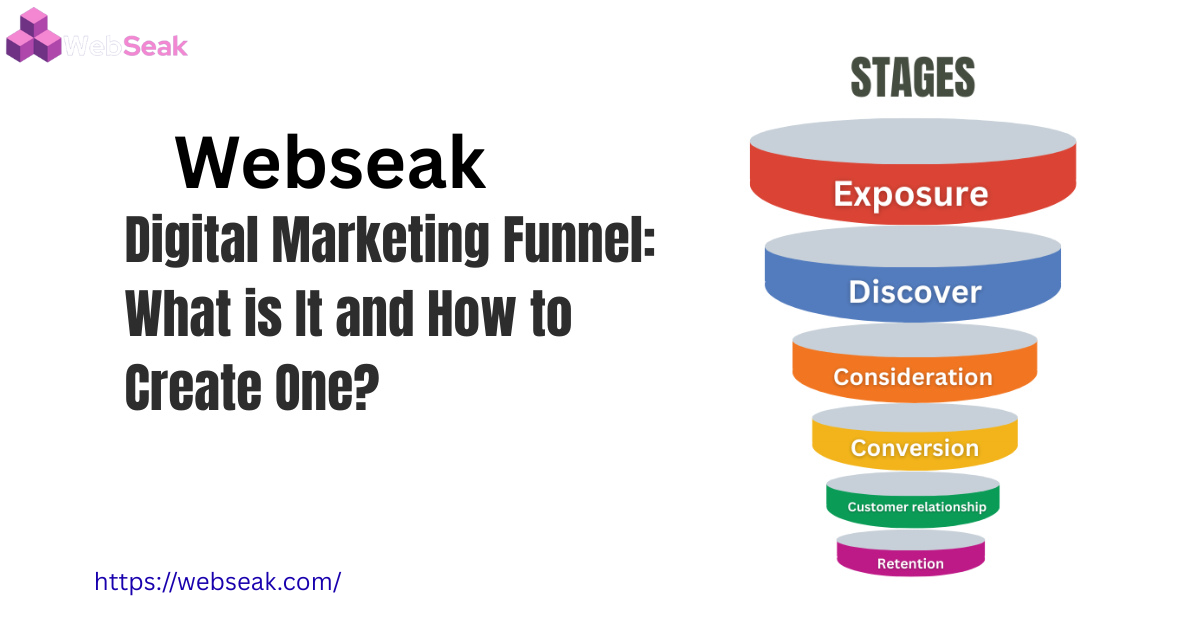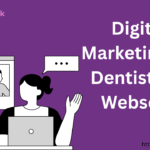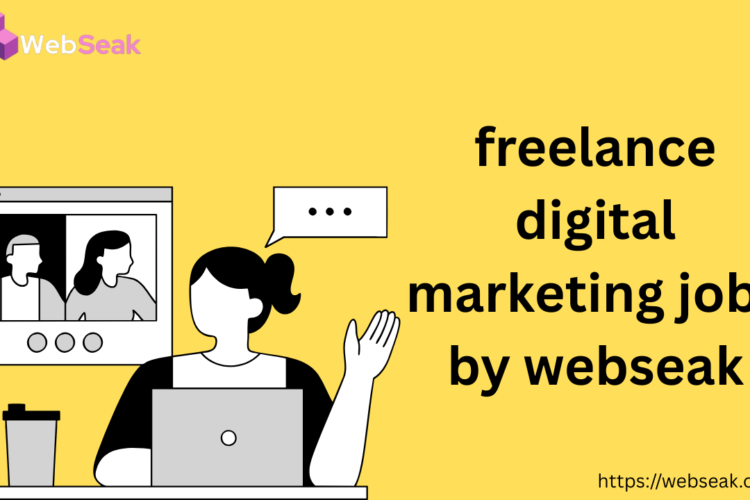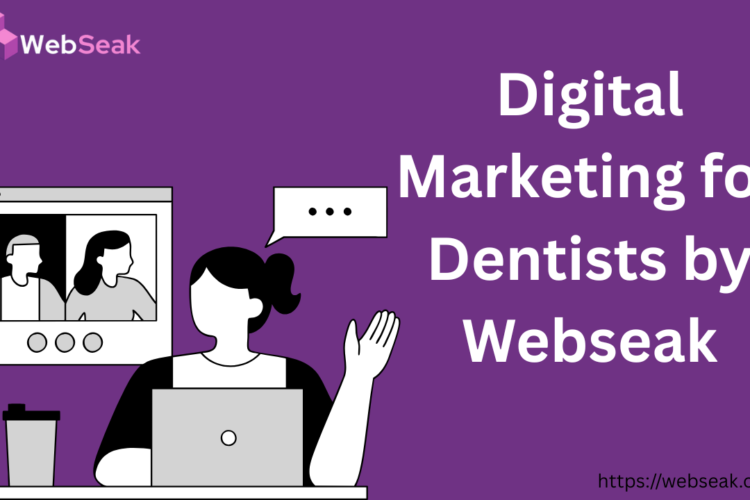
By Webseak
In today’s highly competitive digital world, a clear strategy is essential for turning website visitors into loyal customers. One of the most powerful tools in digital marketing is the marketing funnel. Known as the digital marketing funnel, it maps the customer journey from first interaction to final conversion.
Whether you are a small business owner, a digital marketer, or a startup founder, understanding the digital marketing funnel can help you target the right audience, improve engagement, and boost sales. In this article, Webseak explores everything you need to know about the digital marketing funnel and how to use it effectively.
Table of Contents
What Is a Digital Marketing Funnel ?
A digital marketing funnel is a visual representation of the steps a user takes from discovering your brand to becoming a paying customer. It includes stages like awareness, consideration, conversion, and retention.
Imagine a funnel shape. At the top are potential customers who are just learning about your brand. As they move through the funnel, only a percentage of them convert into buyers. The funnel helps marketers understand where to focus efforts to increase conversion rates.
Why the Digital Marketing Funnel Matters ?
The digital marketing funnel matters because it helps businesses:
- Understand user behavior
- Identify weak points in their customer journey
- Personalize messaging for each stage
- Align marketing strategies with business goals
- Improve ROI on campaigns
By breaking down the funnel, businesses can develop tailored content and strategies for each step in the journey.
Key Stages of the Digital Marketing Funnel
Let’s break down the main stages of the digital marketing funnel and explore what tactics work best at each level.
1. Awareness Stage
Goal: Attract attention and generate interest
This is the top of the funnel. Users in this stage do not know your brand yet. Your job is to grab their attention and educate them about the problems your products or services can solve.
Tactics for Awareness Stage
- Search engine optimization SEO
- Social media posts and ads
- Blog articles
- Video marketing
- Infographics
- Webinars
Your content should be educational not promotional. Focus on topics that solve common problems for your target audience.
2. Consideration Stage
Goal: Nurture interest and provide value
Now that your audience knows who you are, they are evaluating whether your product or service fits their needs. In this middle stage, build trust and highlight your unique value.
Tactics for Consideration Stage
- Email newsletters
- Case studies
- How-to guides
- Product comparisons
- Whitepapers
- Retargeting ads
At this point, people want deeper insights into how you can help them. Provide proof of your success and start forming a stronger relationship.
3. Conversion Stage
Goal: Encourage users to take action and make a purchase
This is the bottom of the funnel. Your leads are ready to make a decision. You need to make it as easy as possible for them to say yes.
Tactics for Conversion Stage
- Clear call to action CTAs
- Free trials or demos
- Special offers or discounts
- Testimonials and reviews
- Landing pages optimized for conversion
- Chat support or sales consultations
This is where you convert visitors into paying customers. Eliminate obstacles and build confidence.
4. Loyalty and Retention Stage
Goal: Turn customers into repeat buyers and brand advocates
Once a customer makes a purchase, your work is not done. Retaining them is more cost-effective than acquiring new ones. You want to keep them engaged and turn them into brand loyalists.
Tactics for Retention Stage
- Loyalty programs
- Post-purchase follow up emails
- Educational content for existing users
- Surveys and feedback
- Referral programs
Satisfied customers will keep buying and refer others to your brand. Keep delivering value after the sale.
Building Your Digital Marketing Funnel Strategy
Every business is different. Your funnel needs to be customized to your goals, audience, and product. Follow these steps to build a successful funnel.
Step 1: Know Your Audience
Start by identifying your ideal customer. Create detailed buyer personas based on:
- Demographics
- Pain points
- Goals
- Buying habits
Understanding your audience allows you to create more relevant content and messaging.
Step 2: Create Content for Each Funnel Stage
Your content strategy should address each stage of the funnel. For example:
- Blog posts for awareness
- Case studies for consideration
- Landing pages for conversion
- Email campaigns for retention
Use different formats like video, email, social posts, and long form articles to reach your audience where they are.
Step 3: Implement Lead Capture Tools
Once you attract visitors, capture their information using:
- Signup forms
- Popups
- Gated content like ebooks
- Chatbots
Store this data in a CRM tool to segment and nurture leads effectively.
Step 4: Nurture Leads with Automation
Marketing automation tools like Mailchimp or HubSpot allow you to send targeted emails, track behavior, and score leads. Use these to guide leads down the funnel with minimal manual effort.
Step 5: Optimize for Conversion
Test your CTAs, landing pages, forms, and emails regularly. Use A B testing to find what performs best. Analyze funnel metrics such as:
- Bounce rate
- Conversion rate
- Time on page
- Cost per acquisition
Make data driven changes to improve performance.
Tools to Build and Track Your Funnel
Several tools can help you build and optimize your funnel. Some of the most popular ones include:
- Google Analytics for tracking
- SEMrush or Ahrefs for SEO research
- Mailchimp for email campaigns
- HubSpot for full funnel automation
- Canva for content creation
- Unbounce for landing page testing
Choose tools based on your budget and marketing objectives.
Common Mistakes in Funnel Marketing
Avoid these common digital funnel mistakes:
- Ignoring one or more funnel stages
- Creating only sales content
- Not tracking performance metrics
- Using generic messaging
- Delaying follow-ups
A balanced strategy across all stages ensures better results.
Final Thoughts
The digital marketing funnel is the backbone of every successful online business strategy. When used correctly, it can guide users from the point of discovery to loyal brand advocacy.
By understanding each stage and using the right tools and tactics, businesses can create a seamless journey that improves engagement, trust, and ultimately, revenue.
At Webseak, we believe that every business regardless of size can benefit from a well structured digital marketing funnel. Whether you are looking to build awareness or increase customer loyalty, the funnel gives you the roadmap to get there.
Start building your digital marketing funnel today and turn your online visitors into lifelong customers.





